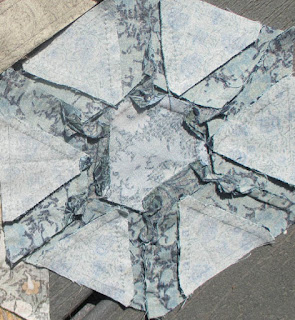A friend of a friend recently scored big in buying this quilt.
How old is it, she asked.
O-L-D!!!
I've been thinking a lot about early quilt styles in the U.S. so I was glad to have a puzzle to figure out. putting into words why I think it's older than she guessed, which was about 1840. We'll look at the clues to age using comparative dating, matching the undated quilt above to quilts with dates inscribed on them.
The mystery quilt would not be any earlier than about 1775---American patchwork tends to be about as old as the U.S. itself.
TECHNIQUES
Techniques include conventional applique, which doesn't really help. I asked if this feather with a bowknot was reverse applique but it's regular old surface applique.
Quilt date-inscribed 1795 by Jane Gatewood
STYLE
The quilt in question could be described as an appliqued medallion of limited colors with a fringe border. Medallions with a central focus were more popular before 1840 than after, but that style characteristic is not much of a clue.
That edge treatment looks like a netted fringe (but I know
little about fringes.)
The main thing to know about fringes and other added edge treatments is that they are seen in early quilts before 1840 and rarely afterwards. It's a pretty reliable clue. See Jane Gatewood's fringe on her 1795 quilt above.
Collection of the Henry Ford Museum
Esther Bradford's 1807 eagle applique has a knotted or netted fringe.
Style includes the overall color scheme (we'll get to individual fabrics later). The overall look of the quilt: limited color scheme of white with brown and dark blue. Notice that faded heart above. There was once another color here but it's no help now.
Quilt signed Rxx Porter, 177x
Collection of the American Museum in Bath, England
Early American patchwork focused on browns and blues, probably because those were the available cottons, dyed with natural dyes such as madder and indigo. The overall look is rather austere. The absence of bright reds, yellows and greens is a clue of sorts. If we saw Turkey red or chrome orange in there we'd be thinking after 1810 (or more like 1830), so there are no fabrics in the mystery quilt to tell us it's after 1810.
FABRICS
The fabrics are limited, probably due to scarcity. These may have been domestically printed cottons (or perhaps cotton & linen fibers), made in the young U.S. Prints available from American calico printers before 1820 or so tend towards rather simple block-printed designs with rather simple dyes, particularly indigo blues and browns obtained from madder. You also see pinks from madders.
Quilt dated 1804, found in Maine.
Quilt dated 1804 by Mary Stites. Found in the Goschenhoppen
Historians quilt project in Pennsylvania.
The fabrics might have been imported from Europe but before 1820 we see limited variety here.
Quilt dated 1783 by Deborah Wilson
DAR Museum.
The color palette may have been dictated by taste as much as technology and trade. Whatever the cause the look is a clue to an early date.
Quilt dated 1786 by Elizabeth Nace.
Lancaster County Historical Society
Chocolate brown and white.
Indigo blue-ground print and brown figured print
in the quilt in question. Probably wood block prints rather
than cylinder prints. Notice the four-lobed appliqued shape
in this quilt and in the border the Deborah Wilson quilt above.
PATTERN
I've mentioned the bow-knot and simple four-lobed shapes in the applique, both designs seen in the earliest American quilts.
Border patterns include a flowing ribbon and a spindly zig-zag stripe. Is that zig-zag pieced or appliqued? I forgot to ask.
The Connecticut quilt project found this quilt dated 1810
by Anna Ingersoll with a similar flowering ribbon border.
And a spindly, appliqued inner border
Quilt by Harriet DuBois, New Paltz, New York
Collection: Los Angeles County Museum of Art.
The idea of a zig-zag border was also popular with early quilters. Notice the examples in the dated quilts on this page. Date-inscribed examples in my pictures are pieced rather than appliqued and more substantial.
See more pieced borders in this post:
QUILTING
Quilting style and density and techniques can offer clues to date but in this case the quilting looks rather utilitarian. Single diagonal lines---absolutely no help at all. Could be 1775. Could be 1875.
But we have plenty of good clues to indicate that this quilt is early. Exactly how early? Could be last quarter of the 18th century (say roughly as early as 1780!). If we were looking at the quilt in the cloth rather than through photos we might push that date forward due to the prints.
Both blue prints I see in the photos are possible late-18th-century fabrics: wood block figures on indigo grounds. I can't tell the difference between discharged or reserved indigo prints, especially in a photo. That differentiation might make a difference in date. (Discharging 19th century.)
Latest date? 1830? You'd have to be pretty old-fashioned to make a quilt in this style in 1830---so let's say a range of 1780-1825.
Quilt dated 1824 by Mary Taylor. Collection Telfair Museum.
After 1820 you see a real change in fabric variety in American quilts although Mary was sticking
with the zig-zag borders. It's just a different style after the Napoleonic Wars were over and trade
resumed in the late teens.
So my story right now is 1780-1825 and I'm sticking to it---at least until one of you comes up with an argument for a different date.
PS: It's good to know there are still quilts like this on the market.




























































